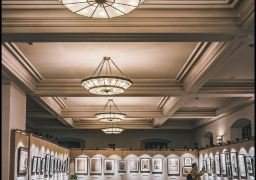Full name is Xujiahui Catholic Church Library in Shanghai, also known as Huitang Stone Chamber. In 1847, the Jesuit Society of Catholicism in Shanghai built a study room in Xujiahui to collect Chinese and Western books. After two expansions in 1860 and 1897, an independent two-story library was formed. Today’s Xujiahui Library not only continues functions such as reading services and document collections but also expands functions such as document research and development and exhibition tourism to meet society’s needs for human cultural heritage – historical buildings and old foreign language documents. The existing Xujiahui Library consists of two buildings staggered north and south: The north building, also known as the large study, was built in 1897. It is a two-story double-sloped roof, brick-wood structure. The north and south façades are equipped with multiple European-style pilasters and pointed arch louvered pine window frames. The design concept and style of the two floors integrate Chinese and Western cultural connotations. The upper floor is the Western language document storage; the lower floor was originally the Chinese language document storage, imitating the style of Tianyi Pavilion in Ningbo in the Ming Dynasty. The south building was originally the Jesuit hospital, also known as the priest building. It was built in 1867. After several renovations, it was fixed as a four-story sloped roof and corridor-style building in 1931. Opening hours: Open from 09:00 to 17:00 from Monday to Saturday all year round; Closed all day on Sunday all year round.







